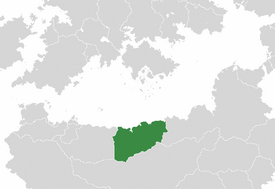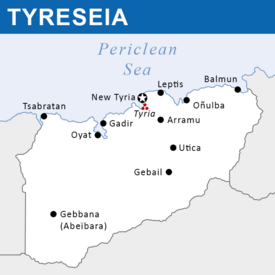Tyreseia
This article is incomplete because it is pending further input from participants, or it is a work-in-progress by one author. Please comment on this article's talk page to share your input, comments and questions. Note: To contribute to this article, you may need to seek help from the author(s) of this page. |
Workers' Federation of Tyreseia Labōrātōrum Foederatio Tyreseiae (Latin) | |
|---|---|
 Location of Tyreseia on the Periclean Basin in North Scipia | |
 | |
| Capital | none specified |
| Largest city | New Tyria |
| Official languages | none at national level |
| Recognised national languages | Tyrian, Latin, Tamaziɣt, Hebrew, Tamashek |
| Ethnic groups (2020) |
|
| Religion | Secular state |
| Demonym(s) | Tyreseian, Tyrian (outdated) |
| Government | Syndicalist directorial federation |
• President of the Council of State | Hasdrubal Fulvius Crassus |
• President of the Supreme Workers' Council | Yoana Wechsler |
| Legislature | Supreme Workers' Council |
| Establishment | |
| Population | |
• 2020 estimate | 33,275,404 |
| GDP (nominal) | 2020 estimate |
• Total | $714,373,343,528 |
• Per capita | $21,468.51 |
| Currency | Tyreseian piastre (TYP) |
| Time zone | UTC+1? (Central Scipian Time) |
| Date format | dd/mm/yyyy (CE) |
| Driving side | right |
| Internet TLD | .tyr |
Tyreseia, formally known as the Workers' Federation of Tyreseia, is a sovereign state in northern Scipia, along the shores of the Periclean Sea. It borders that sea on the north, the Charnean Empire on the south, and Aɣmatia on the west. Tyreseia is a decentralized, worker-led federation laid out along syndicalist principles. The nation is home to a diverse number of ethnicities, religions and languages, all reflecting the various empires, kingdoms, tribes and other civilizations that have inhabited the region over millennia. In Tyreseia's north, large, bustling cities like New Tyria hug the coast, sandwiched between vineyards, farms, and drydocks. In the south, The Axos Mountains dominate the skyline and halt the encroaching desert, itself dotted with river valleys, oases, trade posts, and numerous nomadic tribes who make the hinterlands their home.
In antiquity, the region now known as Tyreseia was ruled by the Tyrian civilization, a conglomerate of city-states led by the eponymous Tyria. The Tyrians were known for their extensive thalassocracy and distinctive purple dye, which remains a symbol of the Tyreseian people to this day. After a fall from grace and a decline in Periclean trading power, the entire region was subsumed by the Latin Empire in the 2nd century BCE. Tyreseia fluorished again under Latin control and cultural influence until the Empire shrank away from the area under both internal and external pressure in the 6th century CE. Following this, the region fractured into various petty kingdoms, chiefdoms, merchant republics, and pirate havens, with a united Tyreseia not to be seen until the mid-19th century.
Over the intervening centuries, the Tyreseian region was plagued by disease, banditry, and factionalism punctuated by repeat Charnean invasions in a time known to Tyreseian historiographers as the Medieval Period or the Dark Ages. These times came to an end when intellectuals like Hinno of Tyria jumpstarted the Tyreseia Movement, a coffeehouse ideology that eventually formed the sociopolitical and philosophical basis for a modern-day Tyreseian state. In a period known as the Springtime of Tyreseia, a series of bloody wars and revolts of unification coincided with a mass resurgence in nearly-extinct Tyrian culture, culminating in the establishment of the Workers' Federation of Tyreseia at the National Proclamation of 1861.
Today, Tyreseia is a stable nation, weathering the transition to a post-industrial economy, fueled by an influx of tourism. Tyreseia is a member of the Forum of Nations and X Pact/Alliance, and engages regularly in international trade and diplomacy.
Etymology
Tyreseia, as a term,
History
The area known today as Tyreseia was likely first inhabited by nomadic tribes around 5000 BCE. Farming techniques originating from western Scipia likely came soon after, with more peoples then settling both along the Periclean and in fertile river valleys. Very little is known about these First Peoples of Tyreseia, as no writing system has ever been found predating the Aradian migration. Early sites at x and y contain both copper and ivory tools, indicating that these peoples engaged in trade with neighboring groups of people. Additional finds suggest a reliance on a diet of fish and cereals, supplemented by a meager supply of pastoral beef; this supply seems to have disappeared around the beginning of the Bronze Age.
The utter lack of solid evidence as to these early peoples' lives is likely compounded by their lifestyles. A site 50 kilometers southeast of Gebayl, is likely the remnants of a Middle Bronze Age city, and one of the best-preserved ruins from the period.
Ancient Tyria
Archaeologists debate the circumstances and exact year in which the city-state of Tyria was founded. 814 BCE, 842 BCE, and 812 BCE have all been floated as possible founding dates, based on varying corroborations of archaeological digs and the testimonies of Tyro-Latin historians writing on the period. According to Tyrian myth, the city was founded by Aradian settlers fleeing the eruption of a volcano in their homeland, generally believed by archaeologists to be the city of Gadir to the west. As the legend goes, the future site was revealed when Baʿal Ḥammon, the chief god of the Aradian mythos and controller of weather, parted the mists and raised the foundations of the gleaming city walls from the silt of the river delta. While the historicity of this creation myth is dubious, excavations around the walls of Tyria indicate that the lower layers were built much earlier than the 9th century BCE. X scholar of the National University of Tyreseia theorizes that a previous civilization may have colonized the TBD River Valley between the First Peoples and the Aradian migration, though this is disputed by others, who suggest that Tyria was built on the site of a yet-unknown First Peoples city.
Regardless of origin, Tyria would quickly prove a jewel in the Aradian crown, as its strategic location at the junction of the TBD River and Periclean Sea trade networks led to a rapid explosion in economic and political power in the following centuries. As the Aradian civilization fell to repeated assaults in XXX BCE, the Tyrian civilization filled the power vacuum and rose to become a Periclean power in its own right. At its territorial peak around 300 BCE, the confederation of Tyrian city-states spanned much of the southern Periclean basin, with a vast patchwork of satellites, colonies, and trading outposts asserting the civilization's mercantile power throughout the rest of the region. Tyreseians often cite this period as the origin of their strong maritime tradition, thanks to the commanding presence Tyria held in early antiquity.
While nominally under the command of the city of Tyria, city-states on the periphery of the polity would often function on a tribute system, sometimes with the autonomy to wage their own wars and hire their own mercenary armies. Generally, though, the inner cities would be governed by a shofeṭ (Tyrian: šūfeṭ), elected from the wealthy merchant families much like an ancient Latin consul. These shofeṭim would meet in Tyria and run the Tyrian mercantile empire through the Senate (Tyrian: Drm), similar to the contemporary Latin Senate, but without a figurehead monarch to rule them. Indeed, the power of the Tyrian merchant families was profound and deep-seated, with power conflicts between the two sometimes erupting into violence and full-blown civil wars. Outside of Tyria itself, these families often maintained extensive connections and properties throughout the Periclean both to express their wealth and secure their mercantile holdings. These families would often finance their own armies of citizens and mercenaries in times of both interstate and intrastate conflict, often far dwarfing the size of the Tyrians' standing army, the Sacred Band. The Tyrian navy, however, was almost always in state hands, and was one of the few standing navies in the ancient world. Historians have credited the navy and its capable commanders with singlehandedly bolstering ancient Tyria's military might and with ushering in a golden age of maritime trade that coincided with the peak of Tyria's territorial expansion around the end of the 4th century BCE.
Tyria's downfall came during the time of the XXXth Council (in XXX BCE). The mercantile Houses of Hiram and Eshmun had, by this time in history, become the most wealthy families in Tyria, with each patriarch being valued as among the richest men in world history and controlling the local politics of several cities. Their rivalry had lasted for centuries, and frequently boiled over into conflict that had crippled the state's treasury and nearly destroyed the once-mighty Tyrian navy. During that year's shofeṭ elections, an attempt by the Hiramites to finance a candidate in a typically Eshmunite-controlled city broke out into civil war. As families and their associated cities began taking sides, the Latin Empire, long jealous of the Tyrian power in the Periclean, began preparations to invade. The Eshmunites consolidated their position within the city of Tyria, while the Hiramites took over the western cities around Tsabratan and appealed to Latium for assistance.
Latin Tyria
Dark Ages
See also: Dictators of Tyria
Reunification
Modern Period
Geography
Administrative Divisions
Government
Legislature
Military
Foreign Affairs
Unions
Education

Education, like most national-level functions in Tyreseia, is highly decentralized and dominated by municipal unions. Nevertheless, national groups like the Tyreseian Congress of Educators and the Higher Education Federation often form baselines to ensure that children across the nation receive a similar education.



